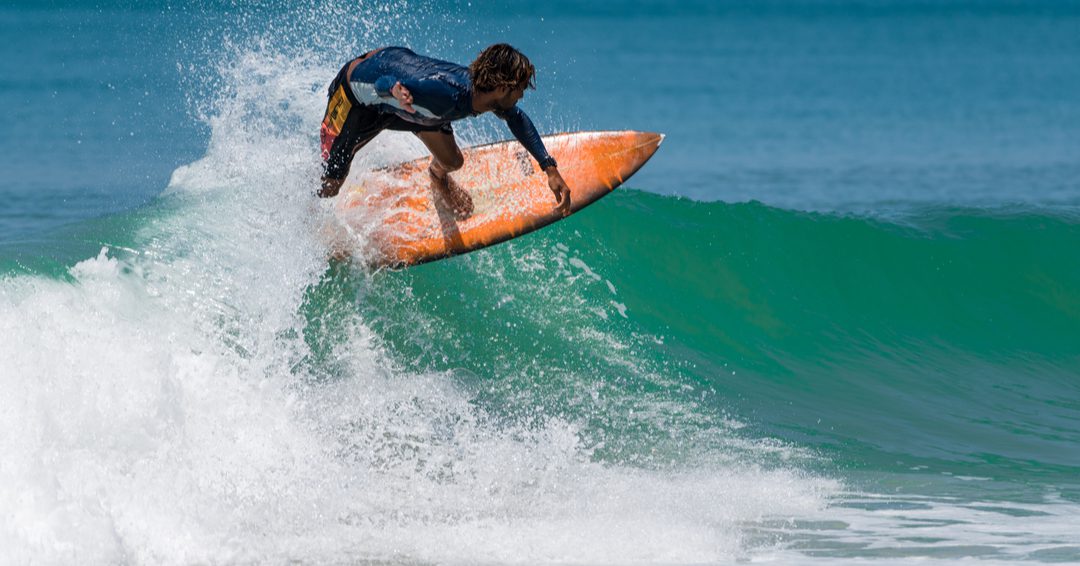(October 10, 2021) Back in the India of the 1970s to spot a saffron clad man riding waves was not a common feature. Probably why when Jack Hebner confidently rode wave after wave along India’s East coast, he captured the imagination of many. The American, who’d embraced the Hare Krishna spiritual movement and made India his adopted home, was a sight for sore eyes. To him, surfing was part of his daily sadhana; a practice that he wanted to extend to other Indians, who seldom appreciated the beauty of their over 7,000-kilometer coast line. What the Surfing Swami, as Hebner was better known, wanted to do was encourage Indians to see their ocean as something other than a giant toilet. An uncomfortable fact, even today.
Come monsoons and some of India’s coasts see waves as high as 20 feet swell and crash against its shores: ideal for surfing. Even during the off season, India offers surfing enthusiasts several spots to explore. To Hebner, the fact that surfing was completely missing in a country with a coastline as long and varied as India’s was strange. In an interview with Surf and Abide, Hebner had said, “We have it all… beach breaks, points, river mouths, reefs and islands. Somewhere all the time a wave is breaking in India and mostly unridden. What we don’t have are crowds, localism and attitudes.”

Jack Hebner brought surfing culture to Indian shores
Sowing the seeds of change
Determined to change that lack of enthusiasm towards surfing, Hebner set up the Mantra Surf Club in Mangalore in 2004, where even today after the disciples complete their morning mantra-meditations, the focus turns to surfing. A major proponent of the surfing culture in India, Hebner was also instrumental in setting up the Surfing Federation of India, the national governing body of surfing in the country. He in many ways, set up the template for the Indian surfing scene.
Despite being a relatively late entrant to the water sport scene, today, the siren call of the ocean swells has lured enough and more surfers into what is now considered a thriving surf scene in the country. With surf schools and clubs across several cities such as Mangalore, Mahabalipuram, Kovalam, Varkala, Covelong, Goa, Mulki, Gokarna, Vishakhapatnam, and Auroville, surfing culture is truly catching on with students as young as 5 and as old as 85 signing up to explore their adventurous sides.

A sport that changed lives
The introduction of the sport has changed many lives: especially for the fishermen who’ve found a new way to thrive in an environment they’ve always loved. Take for instance, Murthy Megavan from Covelong, along the ECR in Tamil Nadu. As a child, the fisherman loved riding the waves in his fishing hamlet. He would use a broken wooden window; this was at a time when he didn’t even know that surfing existed. As he continued embracing the ocean, he came across Hebner one day. “I’d just returned from a fishing trip when I saw Hebner confidently riding wave after wave on a surf board. As he wrapped up and headed towards the shore, I went up to him for a chat. He was so kind and entertained all of my questions that I posed to him in my broken English,” said Murthy. At the end of the 20-minute conversation Hebner agreed to allow Murthy to try out his surf board, not something he often did. Hebner came away impressed and Murthy fell in love with the sport.

Surfing culture changed Murthy Megavan’s life
Today, Murthy Megavan is a well-known name in the domestic surf circuit. He has participated in and won several national level surf championships and has also represented the country internationally. “There is a long way to go. When we compete in international contests, we realize just how far we have to go before we can actually win,” said Murthy, who earlier taught at the Covelong Point Surfing School and is now set to launch his own Murthy Surf School.
Always for a cause
Further up the coast in Mahabalipuram is the Mumu Surf School, which is run by Mumu, a former travel agent. Having grown up in a fishing family, he often interacted with the foreigners who frequent Mahabalipuram and gradually found himself drawn to surfing culture. It is also how he met his wife Anna Goetzke, a German national and fellow surfer. Today, the couple runs the surf school, a rather successful enterprise in the area. Keen on encouraging the sport, the couple lets students who can ill afford fees take lessons for a deal: spend some time cleaning the beach and fill up at least one trash bin.

Students at Mumu Surf School
With a dash of fun
As love for the sport continues to spread across the country with several corporates tying up with these surf schools, surf competitions and festivals have started to become commonplace. In 2014 alone, there were as many as eight surfing competitions held in the country alongside several workshops. Today, the country has approximately 40 surfing schools and around 120 professional surfers. There is no dearth of enthusiasts however, most of them weekend adventure seekers who take occasional lessons and surf for leisure.
India’s surfing scene and competitions has routinely attracted champion surfers from across the globe like Jonty Rhodes, Craig Anderson, Chippa Wilson, Daniel Jones, Kalani Robb, Warren Smith and Trevor Gordon among others. But there’s something for the casual surf enthusiast as well.

A surfer at Surfwala, Arambol
There are plenty of surf schools that offer these enthusiasts a good time and surf lessons all bundled up. Most of these surf schools offer tourists the option of a bed and breakfast or a spot of yoga to turn their weekend more holistic. For instance, in Kerala’s Varkala is Surf & Soul, which offers lessons on a tourist free beach and also sunset yoga classes. On the other side of the country is Surfwala at Arambol in Goa. One of Goa’s most beautiful non-commercial beaches, this is an ideal location to pick up a new skill while on a vacation.
Add to the mix a healthy dose of surf festivals and the whole vibe changes. Take for instance, the annual Surf and Salsa festival that used to be held during the pre-pandemic days in Covelong on ECR. Then there is the India Surf Festival that has been held in Konark since 2012, Summer Swell Challenge in Pondicherry, Spice Coast Open in Kovalam, and Indian Open of Surfing in Mangalore. With water sports, live music performances, tattoo artistes, food stalls and beach parties, these festivals enchant even the non-sporting type.

Ishita Malaviya is India’s first female professional surfer
The sport that’s missing an X chromosome
In stark contrast are India’s women surfers: According to SFI estimates there are only eight or 10 women surfers across the country. Of these is Ishita Malaviya, the country’s first female professional surfer. Ishita began surfing in 2007 in Manipal; when she began competing professionally, her goal was to represent women at surf events. Today, she runs a surf resort near Udupi in Karnataka.
The fact that women surfers are subject to prejudice, unsolicited attention and advice certainly is a huge deterrent for more women taking to the sport in the country. From catcalls and lewd comments, to remarks on their tanned features; India’s women surfers have a lot to contend with.
Popular surf season in India
- May to September for the big waves
- October to April for gentler waters
- Discover more fascinating Stories


